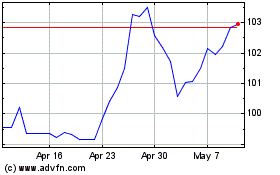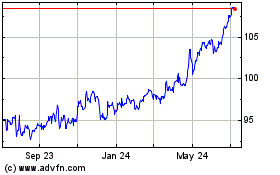Australian Dollar Rises Ahead Of U.S. Jobs Data
March 06 2015 - 1:58AM
RTTF2
The Australian dollar strengthened against the other major
currencies in the Asian session on Friday, as traders await U.S.
jobs report, due later in the day.
The U.S. Labor Department is set to release jobs data for
February, due later. Economists expect the job growth to fall to
240, 000 in February from 257,000 in January, while the
unemployment rate is forecasted to drop 5.6 percent from 5.7
percent.
A strong reading could prompt the Federal Reserve to hike rates
soon.
Sentiment also improved after the European Central Bank detailed
its bond-buying program.
ECB President Mario Draghi revealed on Thursday that the bank
will purchase $66.3 billion worth of bonds each month beginning on
March 9 and expects the impact from it stimulus measures to return
inflation to the euro area next year. The central bank previously
indicated that the $1.1 trillion asset purchase program is expected
to continue until September of 2016.
At its monetary policy meeting, the ECB maintained its interest
rates unchanged for a fifth consecutive session. The ECB also
raised its forecast for European economic growth in 2015 to 1.5
percent from 1 percent.
Meanwhile, data from the Australian Industry Group showed that
the construction sector in Australia contracted at a faster pace in
February, with a Performance of Construction Index score of
43.9.
That's down significantly from 45.9 in January, and it moves
further beneath the boom-or-bust reading of 50 that separates
expansion from contraction. Overall, it's the fourth straight month
of decline.
Thursday, the Australian dollar showed mixed trading against its
major rivals. While the Australian dollar fell against the U.S.
dollar, the yen and the Canadian dollar, it rose against the euro
and the NZ dollar.
In the Asian trading today, the Australian dollar rose to an
8-day high of 1.0419 against the NZ dollar and a 2-day high of
0.9745 against the Canadian dollar, from yesterday's closing quotes
of 1.0388 and 0.9715, respectively. If the aussie extends its
uptrend, it is likely to find resistance around 1.05 against the
kiwi and 0.99 against the loonie.
Against the U.S. dollar, the yen and the euro, the aussie edged
up to 0.7812, 93.75 and 1.4112 from yesterday's closing quotes of
0.7781, 93.47 and 1.4169, respectively. On the upside, 0.80 against
the greenback, 95.49 against the yen and 1.39 against the euro are
seen as the next resistance levels for the aussie.
Looking ahead, the German industrial production for January is
due to be released at 2:00 am ET.
In the European session, Swiss CPI for February, U.K. BoE/GfK's
consumer inflation expectations for next 12 months and first
estimate of Eurozone fourth quarter GDP data are slated for
release.
In the New York session, U.S. jobs data for February, trade
balance and consumer credit - both for January and Canada trade
data for January are set to be published.
At 1:30 pm ET, U.S. Federal Reserve Bank of Dallas President
Richard Fisher will deliver a speech on "State of the Economy and
Farewell, Dallas" before a Dallas Regional Chamber luncheon.
AUD vs Yen (FX:AUDJPY)
Forex Chart
From Mar 2024 to Apr 2024

AUD vs Yen (FX:AUDJPY)
Forex Chart
From Apr 2023 to Apr 2024
